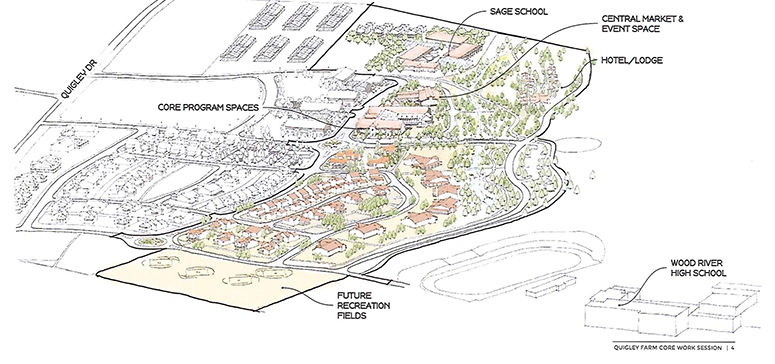Hailey land is earmarked for athletic fields—eventually
May 11, 2018
Click here to read article on the Idaho Mountain Express.
The Blaine County School District took its due piece of the upcoming Quigley Farm development on Tuesday when its board of trustees agreed to accept a swath of land for future athletic fields.
The deal deeds the district 11.12 acres abutting Wood River High School at the mouth of the canyon in Hailey. In the process, the developers clear one of the few hurdles that remain between Quigley and its annexation into Hailey: an open-space requirement, which the district’s new lot satisfies.
During its regular May meeting, the school board scrutinized the contract with Quigley Farm—which subjects the BCSD to a design review prior to building on its new property. Leery of placing a public project under a private microscope, board members initially balked at the deal. (In addition to Quigley Farm, any plans would also need approval from the city of Hailey.)
Ultimately, though, the gift was too much to pass up: Following an hour of debate, and after adding a language that the review process can’t “unduly exclude” proposals, the board approved the agreement, 5-0.
“I think this is too valuable an asset, in too prime a location, to let it slip through our fingers,” said Trustee Rob Clayton. “To be honest, it’s just too good. I don’t want to blow this one.”
It could be a while before any design for fields comes forward; initial estimates by BCSD Director of Buildings and Grounds Howard Royal put the price of construction between $1.5 million and $2.7 million, with annual maintenance running another $30,000 to $35,000.
In her pitch to the board, Hailey Community Development Director Lisa Horowitz suggested that the city would partner in grant applications to dredge up funding. Still, despite passing a supplemental levy in March, the district has no plans to cut a seven-figure check for fields in the foreseeable future.
“If I could wave a magic wand, maybe,” said Superintendent GwenCarol Holmes. “It’s going to take a good deal of cash to fix our field situation. Even just saying it, I can hear the cash register go ding-ding-ding.”
Until then, Quigley Farm LLC will agree to maintain the property, and its associated water rights, on the district’s behalf.
“We’re making an effort,” said Quigley Farm attorney Jim Laski. “We see this as a win-win.”
According to Horowitz, the property is “integral” to the agreement between the city and the developer. The Blaine County Recreation District, which is based next door at the Community Campus, already accepted a piece of land earmarked for open space—a point that Laski reiterated to the trustees.
“We don’t want veto power, but we don’t want a cinder-block bathroom on the edge of a development we’re trying to sell, either,” Laski said. “The BCRD is happy to have us do a design review on their parcel—that’s just where we are.”
For most of the debate, Trustees Ellen Mandeville and Kevin Garrison remained skeptical.
“My concern is precedent,” Garrison said. “You guys are the first to put an encumbrance on the School District since the federal government did it in 1926.”
Typically, as part of agreements that stand to substantially increase the local population—and with it, student enrollment—the district has received land. The idea, articulated Tuesday by Trustee Kelly Green, is that it may be necessary to build a school to accommodate the growth. Some plots the BCSD has developed; others lay fallow. But, nearly all have been assets that the trustees can manage as they see fit.
(The exception, referenced by Garrison, is a lot in Ketchum across from the Hemingway STEAM School. Given to the district by the U.S. government, that land can’t be sold without an act of Congress.)
With another annexation in the works near Bellevue, Garrison was concerned that future land grants may come with tighter strings.
The private review of public projects isn’t unique, Horowitz said. Any work done to Hailey’s public park in Old Cutters—which was used to fulfill that project’s open space obligation—must be approved by the development’s homeowners association.
“I feel like what’s imposed here is minor, compared to what they can require,” she said.
“I’m a planner,” she added later. “I can’t wait to plan this with you.”
Eventually, the board agreed.
“All right,” Holmes told Horowitz after the vote. “Start looking for those grants.”

